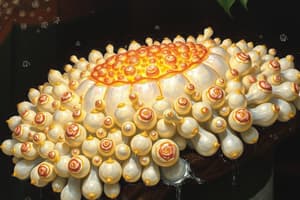Podcast
Questions and Answers
What is materia alba?
What is materia alba?
- A type of bacteria
- A white, bulky material that is loosely connected (correct)
- A dental restoration material
- None of the above
What is the composition of materia alba?
What is the composition of materia alba?
Mushy accumulation of bacteria, desquamated epithelial cells, leukocytes, salivary proteins, and food particles.
Food impaction is the forceful wedging of food into the ______ by occlusal and/or lateral forces.
Food impaction is the forceful wedging of food into the ______ by occlusal and/or lateral forces.
periodontium
Which of the following are signs and symptoms of food impactions? (Select all that apply)
Which of the following are signs and symptoms of food impactions? (Select all that apply)
What are the contributing factors to food retention?
What are the contributing factors to food retention?
Food retention is the same as food impaction.
Food retention is the same as food impaction.
Match the following causes of food impaction with their descriptions:
Match the following causes of food impaction with their descriptions:
What effects can food impaction and retention have?
What effects can food impaction and retention have?
Flashcards are hidden until you start studying
Study Notes
Materia Alba
- White, bulky, curd-like substance that accumulates heavily and is visible without staining.
- Composed of a mushy mix of bacteria, desquamated epithelial cells, leukocytes, salivary proteins, and food particles.
- Does not develop through bacterial growth but rather accumulates without any definite pattern or structure.
Attachment and Incidences
- Forms loosely over plaque on teeth, restorations, calculus, and gingiva.
- More common in unclean areas, particularly among children and adults with poor hygiene practices.
Contributing Factors
- Malalignment of teeth, consumption of a soft diet, and inadequate oral hygiene contribute to the presence of materia alba.
Removal of Materia Alba
- Can be removed through rinsing, brushing, flossing, or professional cleaning—unlike plaque which requires more effort.
Comparisons with Plaque
- Similarities: Distribution on teeth and potential pathologic effects.
- Differences: Appearance, occurrence frequency, ease of removal, and structural composition.
Food Impaction
- Refers to the forceful wedging of food into the periodontium due to occlusal and lateral pressures, affecting interproximal and facial/lingual areas.
Etiology of Food Impaction
- Caused by open contacts, embrasures, occlusal anatomy issues, poor dental work, malocclusion, and overhanging restoration margins.
Signs and Symptoms of Food Impactions
- Often manifests as pressure, vague pain, a foul taste, gingival inflammation, recession, and potential bone loss leading to root caries.
Food Retention
- Involves food staying on teeth and oral mucosa that isn't cleansed by the natural self-cleaning mechanism of the oral cavity.
Etiology of Food Retention
- Influenced by thick saliva, dietary habits, the contour of crowns and gingiva, tooth positioning, and inadequate self-cleansing from lips, cheeks, and tongue.
Factors Affecting Clearance
- Includes salivary flow, viscosity of saliva, mechanical movements of the tongue, cheeks, and lips, and the alignment of dental structures.
Effects of Food Impaction and Retention
- Contributes to periodontal disease and the development of dental caries.
Removal of Food Impaction and Retention
- Mechanical methods are required for impacted food, while retained food can often be removed through rinsing or mechanical means.
Studying That Suits You
Use AI to generate personalized quizzes and flashcards to suit your learning preferences.





